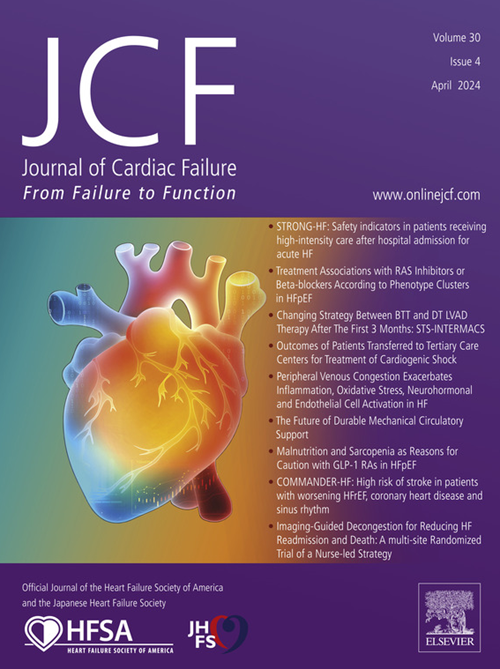Hemodynamic Response after Intra-aortic Balloon Counter-Pulsation in Cardiac Amyloidosis and Cardiogenic Shock
IF 6.7
2区 医学
Q1 CARDIAC & CARDIOVASCULAR SYSTEMS
引用次数: 0
Abstract
Background
In those with heart failure-related cardiogenic shock (HF-CS), an intra-aortic balloon pump (IABP) may improve hemodynamics and be useful as a bridge to advanced therapies. We explore whether those with cardiac amyloidosis and HF-CS might experience hemodynamic improvement and describe the hemodynamic response after IABP.
Methods and Results
We retrospectively identified consecutive patients with a diagnosis of cardiac amyloid, either light chain or transthyretin, who were admitted to our intensive care unit with HF-CS. Patients were excluded if an IABP was placed during heart transplant or for shock related to acute myocardial infarction. Invasive hemodynamics before and after IABP placement were assessed. We identified 23 patients with cardiac amyloid who had an IABP placed for HF-CS. The 1-year survival rate was 74% and most (65%) were bridged to heart transplant, although 1 patient was bridged to destination left ventricular assist device. After IABP, the mean arterial pressure, cardiac index, and cardiac power index were significantly increased, whereas mean right atrial pressure, mean pulmonary artery pressure, and pulmonary capillary wedge pressure were all significantly decreased. A smaller left ventricular end-diastolic diameter (per cm) was associated with a higher likelihood of a cardiac index of <2.2 L/min/m2 after IABP (odds ratio 0.16, 95% confidence interval 0.01–0.93, P = .04).
Conclusions
IABP significantly improved cardiac index while decreasing right atrial pressure, mean pulmonary artery pressure, and pulmonary capillary wedge pressure in cardiac amyloidosis patients with HF-CS.
心脏淀粉样变性和心源性休克患者主动脉内球囊反搏后的血流动力学反应
背景:对于心力衰竭相关性心源性休克(HF-CS)患者,主动脉内球囊反搏泵(IABP)可改善血液动力学,并可作为通向先进疗法的桥梁。我们探讨了心脏淀粉样变性和 HF-CS 患者是否会出现血流动力学改善,并描述了 IABP 后的血流动力学反应:我们通过回顾性研究确定了被诊断为心脏淀粉样变性(轻链或经淀粉样蛋白)的连续患者,这些患者因高频-慢阻肺入住我们的重症监护病房。如果患者在心脏移植过程中或因急性心肌梗死休克而安置了 IABP,则排除在外。对放置 IABP 前后的有创血液动力学进行了评估。我们发现有 23 名心脏淀粉样变性患者因 HF-CS 而置入了 IABP。1年存活率为74%,大多数患者(65%)都接受了心脏移植手术,但有1名患者接受了左心室辅助装置手术。使用 IABP 后,平均动脉压、心脏指数和心脏动力指数明显升高,而平均右心房压、平均肺动脉压和肺毛细血管楔压均明显降低。左心室舒张末期直径越小(每厘米),IABP 后心脏指数达到 2 的可能性越高(几率比 0.16,95% 置信区间 0.01-0.93,P = .04):IABP能明显改善心脏指数,同时降低心脏淀粉样变性患者的右心房压、平均肺动脉压和肺毛细血管楔压。
本文章由计算机程序翻译,如有差异,请以英文原文为准。
求助全文
约1分钟内获得全文
求助全文
来源期刊

Journal of Cardiac Failure
医学-心血管系统
CiteScore
7.80
自引率
8.30%
发文量
653
审稿时长
21 days
期刊介绍:
Journal of Cardiac Failure publishes original, peer-reviewed communications of scientific excellence and review articles on clinical research, basic human studies, animal studies, and bench research with potential clinical applications to heart failure - pathogenesis, etiology, epidemiology, pathophysiological mechanisms, assessment, prevention, and treatment.
 求助内容:
求助内容: 应助结果提醒方式:
应助结果提醒方式:


